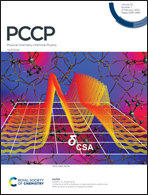Divalent closo-monocarborane solvates for solid-state ionic conductors†
Abstract
Li-ion batteries have held the dominant position in battery research for the last 30+ years. However, due to inadequate resources and the cost of necessary elements (e.g., lithium ore) in addition to safety issues concerning the components and construction, it has become more important to look at alternative technologies. Multivalent metal batteries with solid-state electrolytes are a potential option for future battery applications. The synthesis and characterisation of divalent hydrated closo-monocarborane salts – Mg[CB11H12]2·xH2O, Ca[CB11H12]2·xH2O, and Zn[CB11H12]2·xH2O – have shown potential as solid-state electrolytes. The coordination of a solvent (e.g. H2O) to the cation in these complexes shows a significant improvement in ionic conductivity, i.e. for Zn[CB11H12]2·xH2O dried at 100 °C (10−3 S cm−1 at 170 °C) and dried at 150 °C (10−5 S cm−1 at 170 °C). Solvent choice also proved important with the ionic conductivity of Mg[CB11H12]2·3en (en = ethylenediamine) being higher than that of Mg[CB11H12]2·3.1H2O (2.6 × 10−5 S cm−1 and 1.7 × 10−8 S cm−1 at 100 °C, respectively), however, the oxidative stability was lower (<1 V (Mg2+/Mg) and 1.9 V (Mg2+/Mg), respectively). Thermal characterisation of the divalent closo-monocarborane salts showed melting and desolvation, prior to high temperature decomposition.



 Please wait while we load your content...
Please wait while we load your content...